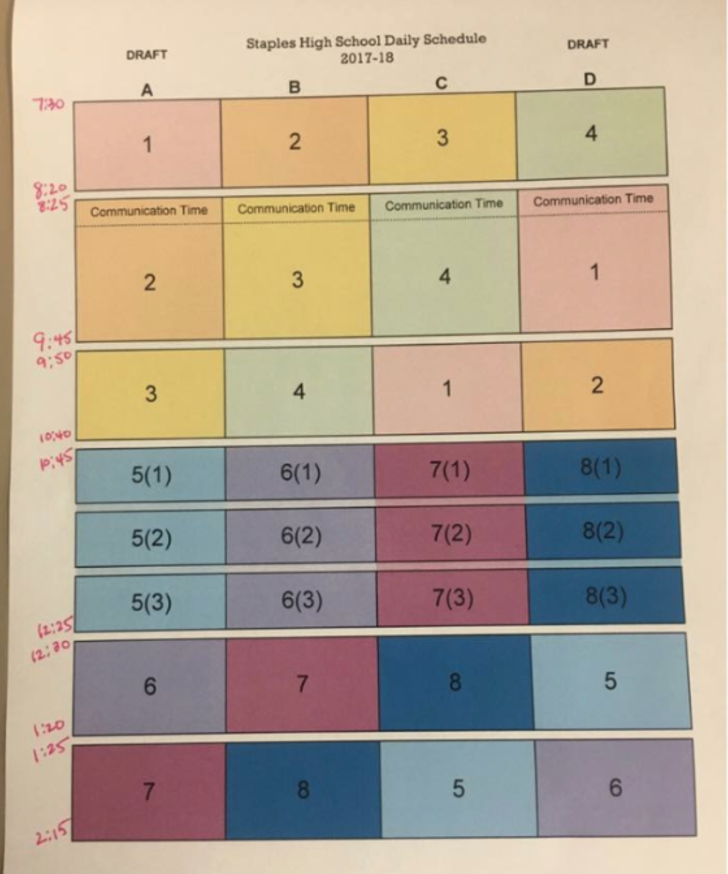By Charles Colasurdo ’18
The announcement of the new schedule for the 2017-18 school year has been met with both praise, criticism and confusion. Proponents tout the proposed efficiency and ease of use of “A, B, C and D” days. Opponents say that it fails to address the stagnation of the current model, where groupings of classes have fixed positions throughout the day, and presents difficulties with long-term planning.
Why the newly-adopted schedule, I wondered? This shift into a four-day schedule was designed to balance the disproportionate number of Mondays missed throughout the school year. The new school day is divided into 6 periods, the first of which is a typical 45-50 minute period, followed by an extended 80-minute period. Each extended period would have 20 minutes of communication time. Extended blocks would be followed by the 45-minute period, and subsequent lunch periods. Afternoons will remain the same.
The Daily Schedule for 2017-18 is the first signal that a modular schedule is the intended direction. So what’s wrong with this? To me, one of the key issues that the new schedule fails to address is, regardless of the day, periods 1 through 4 remain in the morning, and 5 through 8 are fixed in the afternoon. The current fixed back-to-back morning periods 2 and 3 is already lamented by many and the new schedule further restricts classes to their fixed positions throughout the day. What could be the harm of this? A 2016 UChicago study titled, “How the time of day affects productivity: Evidence from school schedules” finds that, regarding math and English classes, “productivity is higher in the morning than the afternoon.”
I don’t like the idea that particular subjects are rigidly locked in for the same time each day. For instance, math would always be in the morning, whereas Biology would only be an afternoon class. Teachers cite the increased amount of absences in the first two periods, which would be unfairly distributed upon periods one through four. Teachers, most of whom have three free periods, may also find an entire section of their day rendered to consecutive planning periods. So, I ask you: What’s to stop them from coming in late or leaving early, as well?
In terms of user-friendliness, the schedule presents challenges in terms of planning for absences and events. Today’s schedule allows for the scheduling of appointments, pre-planned absences and other events well in advance. Planning for such occurrences with the constantly changing cyclic schedule requires extensive knowlege of the exact breakdown of the day. Rather than knowing that a Monday in October will end on period 8, there are three other end-of-day options for class. Regarding school closings for inclement weather and holidays, there are already conflicts with the sequencing of days. Missing school for a snow day would merely omit the day in the schedule, skipping over the snow day’s intended letter, whereas a school holiday would not impede the consecutive lettering. Why is there such a discrepancy between the two? Shouldn’t it just be made uniform so that regardless of the reason, a missed school day would not affect the order, as a skipping a day means more valuable class time lost.
Looking at the new schedule, we can see that each day features an 80-minute, extended period, the beginning of which is slated for 20 minutes of communication time. Rather than this being held only Tuesday-Thursday, as it is now, each day would allot for this. Communication time is often wasted at Staples, where students are mandated to spend valuable classroom time watching a morning show, or in many cases left to their own devices (literally). Rather than 20 minutes of a Netflix marathon, we could be ensuring that teachers are using their precious extended periods to their full potential each and every day.
On the other side, I can see some advantages to this schedule. It makes the days uniform, which is a clear shift away from the “irregularity” of the previous schedule, according to Principal James D’Amico. The new schedule also allots for an equal amount of class time for each of the 8 periods in a student/teacher’s schedule, and ensures that two classes have a full 60-80 minute period. Finally, it helps to alleviate some of the losses of days that occur as a result of holidays, and is supposedly designed to help teachers better plan their classes.
At the end of the day, the jury is still out on whether next year’s modified schedule will be a good move. Only time will tell.















































![[Nov. 2016 Editorial] Battling bystander effect requires administrative change](https://www.inklingsnews.com/wp-content/uploads/2016/11/Screen-Shot-2016-11-22-at-1.05.28-PM.png)

